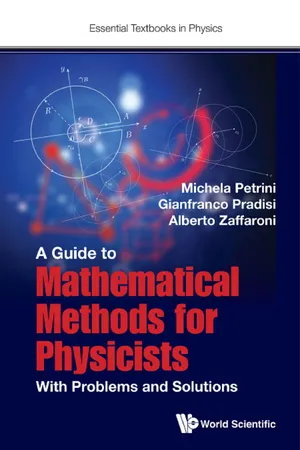
A Guide to Mathematical Methods for Physicists
With Problems and Solutions
- 340 pages
- English
- ePUB (mobile friendly)
- Available on iOS & Android
A Guide to Mathematical Methods for Physicists
With Problems and Solutions
About this book
-->
Mathematics plays a fundamental role in the formulation of physical theories. This textbook provides a self-contained and rigorous presentation of the main mathematical tools needed in many fields of Physics, both classical and quantum. It covers topics treated in mathematics courses for final-year undergraduate and graduate physics programmes, including complex function: distributions, Fourier analysis, linear operators, Hilbert spaces and eigenvalue problems. The different topics are organised into two main parts — complex analysis and vector spaces — in order to stress how seemingly different mathematical tools, for instance the Fourier transform, eigenvalue problems or special functions, are all deeply interconnected. Also contained within each chapter are fully worked examples, problems and detailed solutions.
A companion volume covering more advanced topics that enlarge and deepen those treated here is also available.
--> Contents:
- Complex Analysis:
- Holomorphic Functions
- Integration
- Taylor and Laurent Series
- Residues
- Functional Spaces:
- Vector Spaces
- Spaces of Functions
- Distributions
- Fourier Analysis
- Linear Operators in Hilbert Spaces I: The Finite-Dimensional Case
- Linear Operators in Hilbert Spaces II: The Infinite-Dimensional Case
- Appendices:
- Complex Numbers, Series and Integrals
- Solutions of the Exercises
-->
--> Readership: Students of undergraduate mathematics and postgraduate students of physics or engineering. -->
Complex Functions;Fourier Analysis;Hilbert Spaces;Eigenvalue Problems;Classical Physics;Quantum Physics;Methmatical Methods0 Key Features:
- Chosen topics are treated in depth, always keeping in mind physical applications and practical aspects
- Contains many examples and exercises with solutions for practical use for the students, emphasizing the main purpose of relating concrete physical examples with more formal mathematical aspects
Frequently asked questions
- Essential is ideal for learners and professionals who enjoy exploring a wide range of subjects. Access the Essential Library with 800,000+ trusted titles and best-sellers across business, personal growth, and the humanities. Includes unlimited reading time and Standard Read Aloud voice.
- Complete: Perfect for advanced learners and researchers needing full, unrestricted access. Unlock 1.4M+ books across hundreds of subjects, including academic and specialized titles. The Complete Plan also includes advanced features like Premium Read Aloud and Research Assistant.
Please note we cannot support devices running on iOS 13 and Android 7 or earlier. Learn more about using the app.
Information
PART I
Complex Analysis
1
Holomorphic Functions
1.1.Complex Functions












Table of contents
- Cover
- Halftitle
- Essential Textbooks in Physics
- Title
- Copyright
- Preface
- Contents
- PART I. Complex Analysis
- PART II. Functional Spaces
- PART III. Appendices
- Bibliography
- Index